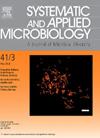Unveiling the hidden microbiome: a microbiological exploration of untouched burial crypts in Krakow, Poland
IF 4.2
2区 生物学
Q2 BIOTECHNOLOGY & APPLIED MICROBIOLOGY
引用次数: 0
Abstract
Cultural heritage objects provide valuable historical information, but can also harbour biological threats. Still, little is said about the potential risks that may await unaware researchers, conservators, and archaeologists. Our work discusses the study results from the crypts in Krakow, which were opened for the first time. The human and coffin remains were examined. The number of actinomycetes, other mesophilic bacteria, bacterial spores, and xerophilic and non-xerophilic fungi was determined. In general, a low number of microbes was observed. However, scanning electron microscope (SEM) images showed many bacterial conglomerates and confirmed that microbial activity affected the fibres covering cadavers in the crypts. The most abundant were mesophilic bacteria, followed by bacterial spores and actinomycetes. They reached up to 107 CFU/g in fabric remains, 5.2 × 106 CFU/g in burial remains, and 1.6 × 106 CFU/g found under the coffin, and above 7.5 × 105 CFU/g for xerophilic and non-xerophilic fungi. NGS (Next-Generation Sequencing) results suggested that the low presence of microorganisms may be due to the dominance of unculturable or long-growing bacteria belonging to Mycobacterium, such as M. coloregonium, M. arupense, and M. pinnipedii. Moreover, other obligatory/non-obligatory pathogens, Bacteroides fragilis, Clostridium botulinum, Coxiella burnetii, Clostridium tetani, Corynebacterium diphtheriae, Enterobacter cloacae, Escherichia coli, Legionella pneumophila, Mycobacterium leprae, Rhodococcus equi, and Staphylococcus aureus have been recorded in examined samples, with the dominance in bone samples. Results indicate the risk of dangerous pathogens present in historical objects, the impact on health may be severe, and the need to use personal protective equipment and proper measures to control the physical conditions of crypts.

揭开隐藏的微生物群:对波兰克拉科夫未被触及的埋葬地穴的微生物探索
文化遗产提供了宝贵的历史信息,但也可能隐藏着生物威胁。然而,对于可能等待不知情的研究人员、保护人员和考古学家的潜在风险,几乎没有人说。我们的工作讨论了克拉科夫地穴的研究结果,这些地穴是第一次打开的。人体和棺材的残骸被检查了。测定了放线菌、其他嗜中温细菌、细菌孢子、嗜干和非嗜干真菌的数量。总的来说,观察到的微生物数量很少。然而,扫描电子显微镜(SEM)图像显示了许多细菌集合体,并证实微生物活动影响了隐窝中覆盖尸体的纤维。最丰富的是嗜中温细菌,其次是细菌孢子和放线菌。织物遗存中最高可达107 CFU/g,埋葬遗存中最高可达5.2 × 106 CFU/g,棺材下最高可达1.6 × 106 CFU/g,而嗜干和非嗜干真菌最高可达7.5 × 105 CFU/g以上。NGS(新一代测序)结果表明,微生物的低存在可能是由于分枝杆菌中不可培养或长时间生长的细菌占主导地位,如M. coloregonium, M. arupense和M. pinnipedii。此外,其他强制性/非强制性病原体,脆弱拟杆菌、肉毒杆菌、伯纳氏杆菌、破伤风梭菌、白喉杆杆菌、阴沟肠杆菌、大肠杆菌、嗜肺军团菌、麻风分枝杆菌、马红球菌和金黄色葡萄球菌在检查样本中也有记录,并在骨骼样本中占主导地位。结果表明,历史文物中存在危险病原体的风险,对健康的影响可能严重,需要使用个人防护装备并采取适当措施控制地穴的物理状况。
本文章由计算机程序翻译,如有差异,请以英文原文为准。
求助全文
约1分钟内获得全文
求助全文
来源期刊

Systematic and applied microbiology
生物-生物工程与应用微生物
CiteScore
7.50
自引率
5.90%
发文量
57
审稿时长
22 days
期刊介绍:
Systematic and Applied Microbiology deals with various aspects of microbial diversity and systematics of prokaryotes. It focuses on Bacteria and Archaea; eukaryotic microorganisms will only be considered in rare cases. The journal perceives a broad understanding of microbial diversity and encourages the submission of manuscripts from the following branches of microbiology:
 求助内容:
求助内容: 应助结果提醒方式:
应助结果提醒方式:


